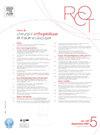La voie d’abord sous-pronatrice du processus coronoïde
Q4 Medicine
Revue de Chirurgie Orthopedique et Traumatologique
Pub Date : 2025-02-06
DOI:10.1016/j.rcot.2025.01.011
引用次数: 0
Abstract
Contexte
L’abord du processus coronoïde en cas de fracture isolée de ce dernier peut nécessiter la réalisation d’une voie antérieure ou d’une voie médiale. Cet abord est à risque de lésion du nerf ulnaire et du nerf médian et plusieurs voies ont été proposées sans qu’un consensus n’ait pu être trouvé. Notre objectif était d’évaluer la faisabilité d’une nouvelle voie d’abord antéro-médiale à distance du nerf ulnaire et d’établir les rapports entre les branches du nerf médian et cette voie en fonction du positionnement du coude. Notre hypothèse était que réaliser l’abord antéro-médial du coude en supination en passant entre le muscle rond pronateur et le fléchisseur radial du carpe permettait d’éloigner les branches motrices du nerf médian de l’abord chirurgical.
Méthodes
Nous avons réalisé une étude anatomique sur 16 coudes chez 16 sujets. L’abord par voie sous-pronatrice était réalisé, puis la distance entre l’interligne articulaire et la naissance des deux premières branches motrices du nerf médian était mesurée. La plus petite distance entre la deuxième branche motrice et la berge médiale de la trochlée dans trois positions différentes (coude tendu en pronation, coude tendu en supination et supination coude fléchi à 90°) était recueillie. Nous avons également établi la destination des deux premières branches motrices du nerf médian.
Résultats
En moyenne, la distance entre la berge médiale de la trochlée et la deuxième branche était de 5,1 mm coude tendu en pronation, 12,8 mm coude tendu en supination, 11,2 mm coude fléchi en supination. La première branche émergeait en moyenne 28 mm en amont de l’interligne et était destinée au rond pronateur dans 100 % des cas. La deuxième branche émergeait 2,9 mm sous l’interligne et avait une ramification pour le rond pronateur dans six cas sur 16.
Discussion
Plusieurs voies sont utilisées dans l’abord du processus coronoïde. Elles comportent chacune leurs complications neurologiques et fonctionnelles propres. La voie sous-pronatrice permet l’abord de la facette antéro-médiale du processus coronoïde sans nécessité de désinsérer les muscles épitrochléens. La supination permet d’éloigner les branches du nerf médian à risque d’être lésées lors de la chirurgie. Une étude de cohorte permettrait de confirmer la sûreté de cette voie d’abord vis-à-vis des structures nerveuses adjacentes.
Niveau de preuve
V.
Introduction
The aim of our study was to describe a new anteromedial approach that allows exposure of the anteromedial facet of the coronoid process, and to characterize the position of the median nerve's motor branches relative to this approach in relation to elbow positioning.
Material and methods
We performed 16 anteromedial approach on fresh anatomical subjects. The minimum distance between the medial edge of the trochlea and the second branch of the median nerve was measured in 3 elbow positions: forearm in supination elbow extended, forearm in pronation elbow extended and forearm in supination elbow flexed at 90°. The distance between the joint space and the origin of the first two motor branches of the median nerve was then measured with the elbow extended.
Results
The mean distance between the second motor branch of the median nerve and the medial edge of the trochlea was 13 ± 3 mm elbow extended and forearm supinated; 5 ± 3 mm elbow extended and forearm pronated; 11 ± 4 mm elbow flexed 90° and forearm supinated. There was a significant difference in distance between the pronated elbow measurement and the two supinated elbow measurements. However, there was no significant difference in the measurement between the elbow flexed in supination and the elbow extended in supination (P < 0.06).
Conclusion
The subpronator approach is a reproducible and reliable approach that allows exposure of the tip of the coronoid process and its anteromedial facet, up to the insertion of the anterior bundle of the medial collateral ligament on the sublime tubercle. We have shown that placing the forearm in supination allows motor branches at risk of injury to be moved away from the surgical site.
Level of evidence
V.
冠状病毒过程的第一次前导途径
在冠状动脉孤立断裂的情况下,冠状动脉过程的开始可能需要实现一个前路或中间路。这种方法有损伤尺骨和中神经的风险,已经提出了几种方法,但没有达成共识。我们的目标是评估一种新的途径的可行性,首先是距离尺骨神经远的前中脉,并根据肘部的位置建立中脉分支与这条途径之间的关系。我们的假设是,通过在前伸肌和桡骨屈肌之间进行俯卧撑来实现肘部内侧前伸,可以使内侧神经的运动分支远离手术前伸。我们对16名受试者进行了16个肘部的解剖研究。首先通过下发音法进行,然后测量关节线与中神经前两个运动分支之间的距离。在三个不同的位置(肘部伸展在发音中,肘部伸展在俯仰中,肘部弯曲在90°俯仰中),第二运动支与斜桁之间的最小距离被收集。我们还确定了中神经的前两个运动分支的目的地。平均而言,槽的中岸与第二支之间的距离为5.1 mm弯腰伸直,12.8 mm弯腰伸直,11.2 mm弯腰伸直。第一个分支平均在线的上游28毫米出现,在100%的情况下,它被设计为一个圆形的突出物。第二支出现在线距下2.9毫米,在16个案例中有6个案例中有一个分支指向圆尖。在冠状动脉过程开始时使用了几种方法。每一种都有自己独特的神经和功能并发症。下发音途径允许冠状动脉过程的前内侧侧进入,而不需要剥离表皮肌肉。在手术过程中可能受损的中神经分支可以被移除。一项队列研究将证实这种方法首先对邻近的神经结构是安全的。证据水平。介绍本研究的目的是描述一种新的冠状动脉治疗方法,允许暴露冠状动脉过程的前医学方面,并表征与肘部位置相关的中神经运动分支的位置。材料和方法我们对新鲜的解剖对象进行了16种解剖方法。我们在3个肘部位置测量了小腿内侧边缘和中间神经第二支之间的最小距离:前臂伸入肘部,前臂伸入发音肘部,前臂伸入肘部弯曲90°。然后用肘部伸展来测量关节空间和中神经前两个运动分支的起源之间的距离。结果:中神经第二运动支与Trochlea内侧边缘之间的平均距离肘部延长13±3 mm,前臂减少;5±3mm肘部伸展,前臂突出;11±4毫米肘部弯曲90°,前臂收缩。我的意思是,我的意思是,我的意思是,我的意思是。然而,肘部屈折和肘部伸伸的测量没有显著差异(P <;0.06)。结论亚前体方法是一种可复制和可靠的方法,允许暴露冠状动脉过程的尖端及其前内侧副韧带,直到将内侧副韧带的前束插入到上皮块茎上。我们已经证明,将前臂放置在俯仰位置可以使运动分支远离手术部位,有受伤的风险。证据的程度。
本文章由计算机程序翻译,如有差异,请以英文原文为准。
求助全文
约1分钟内获得全文
求助全文
来源期刊

Revue de Chirurgie Orthopedique et Traumatologique
Medicine-Surgery
CiteScore
0.10
自引率
0.00%
发文量
301
期刊介绍:
A 118 ans, la Revue de Chirurgie orthopédique franchit, en 2009, une étape décisive dans son développement afin de renforcer la diffusion et la notoriété des publications francophones auprès des praticiens et chercheurs non-francophones. Les auteurs ayant leurs racines dans la francophonie trouveront ainsi une chance supplémentaire de voir reconnus les qualités et le intérêt de leurs recherches par le plus grand nombre.
 求助内容:
求助内容: 应助结果提醒方式:
应助结果提醒方式:


